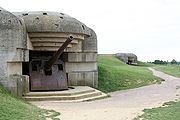
Longues-sur-Mer battery
Encyclopedia

World War II
World War II, or the Second World War , was a global conflict lasting from 1939 to 1945, involving most of the world's nations—including all of the great powers—eventually forming two opposing military alliances: the Allies and the Axis...
artillery battery
Artillery battery
In military organizations, an artillery battery is a unit of guns, mortars, rockets or missiles so grouped in order to facilitate better battlefield communication and command and control, as well as to provide dispersion for its constituent gunnery crews and their systems...
constructed by the Wehrmacht
Wehrmacht
The Wehrmacht – from , to defend and , the might/power) were the unified armed forces of Nazi Germany from 1935 to 1945. It consisted of the Heer , the Kriegsmarine and the Luftwaffe .-Origin and use of the term:...
near the French village of Longues-sur-Mer
Longues-sur-Mer
Longues-sur-Mer is a commune in the Calvados department in the Basse-Normandie region in northwestern France.The Longues-sur-Mer battery is nearby, part of the Atlantic Wall costal fortifications.-Population:-External links:* *...
in Normandy
Normandy
Normandy is a geographical region corresponding to the former Duchy of Normandy. It is in France.The continental territory covers 30,627 km² and forms the preponderant part of Normandy and roughly 5% of the territory of France. It is divided for administrative purposes into two régions:...
. It formed a part of Germany's Atlantic Wall
Atlantic Wall
The Atlantic Wall was an extensive system of coastal fortifications built by Nazi Germany between 1942 and 1944 along the western coast of Europe as a defense against an anticipated Allied invasion of the mainland continent from Great Britain.-History:On March 23, 1942 Führer Directive Number 40...
coastal fortifications.
The battery was completed by April 1944. Although constructed and manned initially by the Kriegsmarine
Kriegsmarine
The Kriegsmarine was the name of the German Navy during the Nazi regime . It superseded the Kaiserliche Marine of World War I and the post-war Reichsmarine. The Kriegsmarine was one of three official branches of the Wehrmacht, the unified armed forces of Nazi Germany.The Kriegsmarine grew rapidly...
, the battery was later transferred to the German army. The site consisted of four 152-mm navy guns, each protected by a large concrete casemate
Casemate
A casemate, sometimes rendered casement, is a fortified gun emplacement or armored structure from which guns are fired. originally a vaulted chamber in a fortress.-Origin of the term:...
, a command post, shelters for personnel and ammunition, and several defensive machine-gun emplacements.
Normandy landings
The battery at Longues was situated between the landing beaches OmahaOmaha Beach
Omaha Beach is the code name for one of the five sectors of the Allied invasion of German-occupied France in the Normandy landings on 6 June 1944, during World War II...
and Gold
Gold Beach
Gold Beach was the code name of one of the D-Day landing beaches that Allied forces used to invade German-occupied France on 6 June 1944, during World War II....
. On the night before the D-Day
D-Day
D-Day is a term often used in military parlance to denote the day on which a combat attack or operation is to be initiated. "D-Day" often represents a variable, designating the day upon which some significant event will occur or has occurred; see Military designation of days and hours for similar...
landings of 6 June 1944, the battery was subject to heavy bombing from allied air forces. The bombing was followed from 0537hrs on the morning of the landings by bombardment from the French cruiser Georges Leygues
French cruiser Georges Leygues
The Georges Leygues was a French light cruiser of the La Galissonnière class. During World War II, she served with both the Vichy France and Allies. She was named for the prominent 19th and 20th century French politician Georges Leygues....
as well as the U.S. battleship Arkansas
USS Arkansas (BB-33)
USS Arkansas , a was the third ship of the United States Navy named in honor of the 25th state.A dreadnought battleship, Arkansas was laid down on 25 January 1910 at Camden, New Jersey, by the New York Shipbuilding Corporation. She was launched on 14 January 1911 sponsored by Miss Nancy Louise...
. The battery itself opened fire at 0605hrs and fired a total of 170 shots throughout the day, forcing the flagship HMS Bulolo to retreat to safer water. Three of the four guns were eventually disabled by British cruisers Ajax
HMS Ajax (22)
HMS Ajax was a Leander class light cruiser which served with the British Royal Navy during World War II. She became famous for her part in the Battle of the River Plate, the Battle of Crete, the Battle of Malta and as a supply escort in the Siege of Tobruk. This ship was the eighth in the Royal...
and Argonaut
HMS Argonaut (61)
HMS Argonaut was a Dido class cruiser-References:***...
, though a single gun continued to operate intermittently until 1900hrs that evening. The crew of the battery (184 men, half of them over 40 years old) surrendered to the 231st Infantry Brigade the following day. The heaviest damage was caused by the explosion of the ammunition for a AA gun, mounted by the British on the roof of casemate No.4, which killed several British soldiers.
External links
- The Batterie at Longues sur Mer at Kremm's world military interest website
- Photos from Longues-sur-Mer Battery

